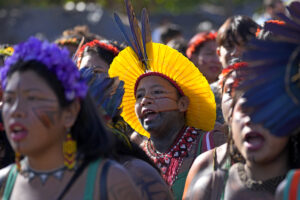The People’s Game, Part Three: The 2014 Copa do Mundo as a Window to the World
The World Cup is the world’s most popular spectacle and, as such, speaks volumes about the state of humanity today. A protester plays with a soccer ball as riot police stand guard in Sao Paulo, Brazil. AP Photo/Dario Lopez-Mills
A protester plays with a soccer ball as riot police stand guard in Sao Paulo, Brazil. AP Photo/Dario Lopez-Mills
By Alan Minsky and Meleiza FigueroaThis article is part of a series. Read part one here, and part two here.
The World Cup is the world’s most popular spectacle and, as such, speaks volumes about the state of humanity today. This year’s event is far more than a soccer tournament in Brazil. It encompasses millions of social and civic gatherings across the globe, a tsunami of digital posts and communications, a physical and virtual carnival. This gives us a month-long window into the mind of the global masses in 2014, and also into how the global 1 percent takes control of the most popular human activities and puts them to use for its own purposes. Even if Brazilian protesters were not taking the opportunity presented by the World Cup to challenge the very logic of the globalized neoliberal economic order and its spectacles, we’d argue that anyone who calls him- or herself a progressive or leftist should sit up and take note of the World Cup and its global audience.
Before offering some observations on what we can discern from the hundreds of millions who are fervently following the tournament, we want to discuss a few massive “constituencies” who do not make up the traditional base of World Cup fanatics: women, India and China, and the U.S. If the World Cup’s tremendous global popularity tells us something about the people of the world today, then it also reveals insight into the people less drawn to this spectacle, which is now being projected into almost every sizable community across the globe.
The relation of women to sports and, in particular, male-dominated spectator sports is, of course, a subject far too large to do justice here, but it is an essential component to address if we are to get a grip on humanity’s most popular spectacle and what it tells us about ourselves.
Although there are nuances and exceptions across the globe, on balance the culture of soccer fans has been male dominated and highly patriarchal throughout the history of the sport and remains so to this day. Thus, the fact that the men’s World Cup is casually recognized as the world’s most popular event, and that the gendered nature of the spectacle is accepted as the norm, speaks volumes about the state of gender relations globally.
The World Cup is, of course, much more than the games themselves; it extends to the social spaces where the games are watched and into the advertising blitzes that accompany the tournament — which in both cases are almost universally constructed to welcome the “real men” fans of the game, while marginalization and objectification are as often as not the order of the day for women and other fans from historically subjugated social groups. This, of course, should be called out and fought in every manner possible, as a global community must welcome all people to the party equally.
The two authors of this essay have experience with soccer culture in two of the sport’s core countries: Meleiza in Brazil and Alan in Italy. In both cases, club soccer culture is highly gendered and at times frighteningly sexist. However, the hyper-sexist culture of club soccer fans is only somewhat replicated during the men’s World Cup, which many more women follow in both countries — a trend that appears to be true across the globe. Thus, in many ways the men’s World Cup tournament provides an opportunity to observe patriarchy in action around the world as well as to critique and combat it.
Of course, the great hope for soccer as a means to combat global patriarchy lies in the rise of the women’s game. As rapidly as the men’s game is growing, it is surpassed by the rate of growth of women’s soccer, as more and more girls and women the world over are playing organized soccer. Certainly both the Olympics and tennis provide examples of sports in which fan interest, and resource investment, is more balanced than soccer (though neither are yet equitable). It’s very possible that women’s soccer will become the most popular sport among women to the same degree that it prevails among men. It will no doubt take considerable struggle against entrenched patriarchy, but due to soccer’s phenomenal grip on the public’s imagination, there is considerable potential for it to become one of humanity’s chief weapons against gender inequality in the coming decades.
Shifting gears to the question of China and India: Detractors of soccer’s claim to be the global game point out that neither China nor India (which account for over a third of the world’s population) are traditional soccer hotbeds. However, soccer is now recognized as the most popular sport in China and second in India (to cricket), and both countries have seen tremendous growth in television viewership of top European leagues over the past four years, leading to speculation that this year’s World Cup will be more popular in both countries than ever before. (Though it should be noted that the substantial time difference between Brazil and those two countries will undoubtedly depress live TV viewing numbers; if the growth of the sport continues apace in China and India over the next four years, expect the 2018 World Cup in Russia to shatter the global all-time viewership records for this reason.) Still, the question of whether soccer will capture the imagination of the Chinese and Indian populations in a manner comparable to Europe, Africa, South America and the Middle East remains an open question; and just how popular this year’s tournament will be in the world’s two largest countries will be interesting to follow. At any rate, it is clear that a growing number of Indian and Chinese people have caught the soccer bug, and greater access to satellite broadcasts means the sport is well on its way to overcoming another barrier on its messianic mission to unify humanity.
As for the good ol’ USA, a huge country itself and still the world’s largest economy, soccer has grown in leaps and bounds to the point that it is the most played youth sport in the land, but as a spectacle it still falls behind American football, baseball, basketball and even hockey (though it should be noted that the U.S. certainly qualifies as a sports-mad country, and thus the amount of money generated by even the fifth most popular spectator sport is more than healthy). And soccer is closing the gap rapidly. In its first week and a half, the 2014 World Cup shattered previous viewing records as the U.S. defied the odds by doing well in the “Group of Death” round, and other games featured more drama and many more goals than in recent men’s World Cups.
More significant for the long term, Major League Soccer has established itself, global soccer has started building a year-round audience, and with each passing year more and more former youth players come of age and become adult sports fans. Of course, the U.S.’ relationship to the global game is unique in other ways, most particularly in the rival popularity of the women’s game domestically and the fact that outside of immigrant communities, the sport is more rooted in prosperous communities than in working-class ones. This, of course, means that a disproportionate amount of advertising money is attracted to the sport even if other sports have larger audiences.
Another salient aspect of the U.S.’ relationship to soccer is that the sport’s popularity is rising at the very time that America’s global cultural hegemony seems to be on the wane. Indeed, throughout the era of America’s greatest cultural influence, the post-WWII decades, global soccer was a huge phenomenon that operated away from the influence of the cultural hegemon (the U.S.). This, no doubt, was attractive to those who opposed U.S. imperialism (whether of the soft or hard variety). Now that the U.S. is becoming established as a more prominent member of the international soccer community (the men’s team has now qualified for seven straight World Cups, and the women are stalwarts), perhaps this presages the U.S. accepting a more balanced role in the community of nations. Such a suggestion might seem like a stretch, but in an increasingly globalized world, the percent of Americans comfortable as international bullies may decline as more of them embrace a “foreign” sport and get integrated into the global game.
Leaving the land of wealthy suburbanite footballers, let’s return to the question of what we — in particular, those of us on the political left — can learn about the global masses from World Cup 2014, There is a persuasive argument that in large parts of the world (Brazil and Latin America may be an exception in this regard), the “left” is no longer able to connect with the majority of the population (which by definition the left is supposed to represent). The argument goes that when it comes to specifics, the left’s appeals to social justice and economic equality are rooted in an antiquated conception of human subjectivity — or, at least, of human aspirations.
To put it another way, and to be less theoretical, the left is living in the past and doesn’t know where people’s heads are today; this is so much so that the vast majority of people across the globe are furiously indignant about the vast fortunes and overwhelming political control of the 1 percent but, judging by their actions, seem willing to accept this state of affairs. With few exceptions, the global 99 percent are largely docile, and this summer, instead of protesting, they’re watching the World Cup (not that the two have to be mutually exclusive). Well, what better way to learn about what people really want than to watch them engaged in something they really love: the World Cup?
This is not meant glibly. We can learn a lot about humanity from the carnival: about which elements of the status quo people want to subvert and which elements they embrace. But most particularly, you get a clear sense of how people would like to live. The World Cup 2014 will offer up a sense of this in more parts of the world than any global event to date. Will work be sacrificed for the spectacle? How will communities gather? Will the sense of palpable solidarity extend beyond national boundaries? Will it feel global? How will people integrate the new technologies of the day? What will it tell us about 21st-century subjectivity in this era of instant global interconnectivity? Which visions of freedom and equality are expressed? And, of course, what kinds of political dissent will be apparent?
As for the question “is it all bread and circuses?” — by which we mean a distraction from the injustices of our time — the answer is undoubtedly no. It’s not “all” bread and circuses. To a certain degree, yes, but not “all.” There’s no denying that people really love soccer. Will they do so at some later date when they live in a society less rife with alienation? Who knows? We don’t live in such a time. Do they love soccer so much now because it’s delivered across the globe as this source of fun and excitement by the mechanisms of corporate controlled media? Sure, but that too is part of the world we live in. There’s as much evidence as not that people would crave just such a spectacle in any future society; after all, what else can we go on but the evidence up to the present? In our time, people love soccer.
Indeed, the left must accept that people love much of what makes up life in this fragmented, contradictory era. Nonetheless, there remains a craving for social justice, for fair treatment. Watching the world at play this summer should provide clues as to what kind of better society would appeal to the billions of people in the varied regions of the planet.
The struggle over what global soccer is, and means, to people the world over is, therefore, a crucial aspect of what cultural theorist Antonio Gramsci called the struggle for hegemony. Informed by his extensive studies on language, Gramsci’s concept of hegemony as a form of power involved not simply how the institutions and spectacles of the elite impose their interests on the rest of society, but also how systems of meaning, or “common sense,” function as a common “language,” or framework, by which people understand, accept and contest the social relations that structure their everyday lives.
Soccer — by virtue of its widespread accessibility, relative simplicity of play and ability to inspire unbridled passion and ecstasy — is a kind of universal language, a mode of expression that brings people together in both conflict and community. It is, literally and figuratively, a “playing field” on which, as the late Stuart Hall put it, “power relations are both established and potentially unsettled.”
Game on. The whole world is watching.
Meleiza Figueroa is a doctoral candidate in geography at UC Berkeley who is doing her dissertation research in Brazil. Alan Minsky is program director of KPFK Radio in Los Angeles, and a frequent contributor to Truthdig. They are the co-producers of “The People’s Game” radio show, which can be listened to live each Wednesday during the World Cup at kpfk.org. Show archives and daily podcasts will be available online at thepeoplesgame.org.
Your support matters…Independent journalism is under threat and overshadowed by heavily funded mainstream media.
You can help level the playing field. Become a member.
Your tax-deductible contribution keeps us digging beneath the headlines to give you thought-provoking, investigative reporting and analysis that unearths what's really happening- without compromise.
Give today to support our courageous, independent journalists.






You need to be a supporter to comment.
There are currently no responses to this article.
Be the first to respond.